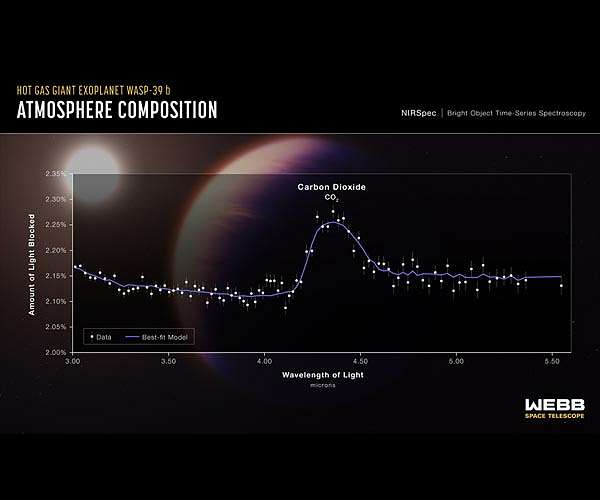
Webb telescope finds CO2 for first time in exoplanet atmosphere (Image Credit: Space Daily)
The months-old James Webb Space Telescope has added another major scientific discovery to its growing list: detecting for the first time signs of carbon dioxide in the atmosphere of a planet outside our solar system.
Although the exoplanet would never be able to support life as we know it, the successful discovery of CO2 gives researchers hope that similar observations could be carried out on rocky objects more hospitable to life.
“My first thought: wow, we really do have a chance to detect the atmospheres of terrestrial-size planets,” tweeted Natalie Batalha, a professor at the University of California at Santa Cruz and one of hundreds who worked on the Webb project.
Their study of exoplanet WASP-39, a hot gas giant closely orbiting a star 700 light years away, will soon be published in the journal Nature.
“For me, it opens a door for future research on super-Earths (planets larger than Earth but smaller than Neptune), or even Earth-sized planets,” Pierre-Olivier Lagage, an astrophysicist with France’s Atomic Energy Commission (CEA), told AFP.
The detection of CO2 will also help scientists learn more about how WASP-39 formed, NASA said in a press release. The exoplanet, which orbits its star once every four Earth days, has a mass one-quarter that of Jupiter but a diameter 1.3 times bigger.
The frequency of its orbit and large atmosphere made WASP-39 an ideal candidate for an early test of Webb’s state-of-the-art infrared sensor, known as NIRSpec.
Each time the exoplanet crosses in front of its star, it blocks out an almost imperceptible amount of light.
But around the edges of the planet, a tiny amount of light passes through the atmosphere.
Webb’s highly sensitive NIRSpec can detect the small changes that the atmosphere has on the light, allowing scientists to determine its gas composition.
The Hubble and Spitzer telescopes had already detected water vapor, sodium and potassium in WASP-39’s atmosphere, but carbon dioxide can now be added to that list thanks to Webb and its NIRSpec instrument.
“It was a special moment, crossing an important threshold in exoplanet sciences,” said Zafar Rustamkulov, a Johns Hopkins University researcher, in the NASA press release.
la/des/bfm
Related Links
Lands Beyond Beyond – extra solar planets – news and science
Life Beyond Earth
|
|
Tweet |
|
|
|
We need your help. The SpaceDaily news network continues to grow but revenues have never been harder to maintain. With the rise of Ad Blockers, and Facebook – our traditional revenue sources via quality network advertising continues to decline. And unlike so many other news sites, we don’t have a paywall – with those annoying usernames and passwords. Our news coverage takes time and effort to publish 365 days a year. If you find our news sites informative and useful then please consider becoming a regular supporter or for now make a one off contribution. |
||
|
SpaceDaily Monthly Supporter $5+ Billed Monthly
|
SpaceDaily Contributor $5 Billed Once
credit card or paypal |
|
Scientists say exoplanet 100 light years from Earth may be covered with deep ocean
Washington DC (UPI) Aug 24, 2021
A team of researchers have discovered an exoplanet about 100 light years away from Earth in the Draco constellation, and they say the world appears to be covered in a deep ocean.
The exoplanet – called TOI-1452b – is slightly larger than the Earth and is located in a “Goldilocks zone,” where temperatures are neither too hot nor too cold for liquid water to exist. Therefore, astronomers think TOI-1452b could be covered in an ocean.
The exoplanet orbits “a nearby visual-binary M dwarf” s … read more






